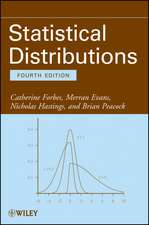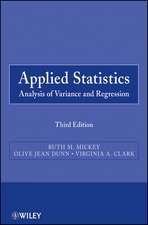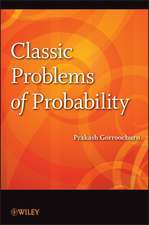Quantitative Methods in Biological and Medical Sciences: A Historical Essay
Autor H.O. Lancasteren Limba Engleză Paperback – 26 sep 2011
Preț: 389.31 lei
Nou
Puncte Express: 584
Preț estimativ în valută:
74.50€ • 77.50$ • 61.51£
74.50€ • 77.50$ • 61.51£
Carte tipărită la comandă
Livrare economică 14-28 aprilie
Preluare comenzi: 021 569.72.76
Specificații
ISBN-13: 9781461276241
ISBN-10: 1461276241
Pagini: 316
Ilustrații: XVII, 297 p.
Dimensiuni: 155 x 235 x 17 mm
Greutate: 0.45 kg
Ediția:Softcover reprint of the original 1st ed. 1994
Editura: Springer
Colecția Springer
Locul publicării:New York, NY, United States
ISBN-10: 1461276241
Pagini: 316
Ilustrații: XVII, 297 p.
Dimensiuni: 155 x 235 x 17 mm
Greutate: 0.45 kg
Ediția:Softcover reprint of the original 1st ed. 1994
Editura: Springer
Colecția Springer
Locul publicării:New York, NY, United States
Public țintă
GraduateCuprins
1. Greek Science.- 1. Atomism.- 2. Forms and Ideas.- 3. Aristotle.- 4. Canons of Experimentation.- 2. Later Influences of the Greek Authors.- 1. Atomism and Modern Biology.- 2. Solids and Liquids in Living Beings.- 3. Platonic Science in Modern Biology.- 4. Classification and Comparative Method.- 5. Canonical or Stratonic Science.- 6. Mathematization of Other Sciences.- 3. Microscopic World and the Structure of Living Organisms.- 1. Biodiversity.- 2. From Microbes to Cells.- 3. Size and Structure of Living Organisms.- 4. Applied Mathematics.- 5. Biologists’ Views on the Use of Mathematics.- 6. Francis Galton.- 4. Genetics.- 1. Genetics Before Mendel and Galton.- 2. Mendel.- 3. Stability of the Gene Frequencies.- 4. Evolution and Genetics.- 5. Rediscovery of Mendel’s Work.- 6. Pure Lines.- 7. Major Genes and Polygenes.- 8. Wilhelm Weinberg as a Medical Statistician.- 9. Anatomical Basis of Heredity.- 10. Genetic Linkage.- 11. Biometrical Genetics.- 12. Karl Pearson as a Geneticist.- 13. R.A. Fisher as a Geneticist.- 5. Human Genetics.- 1. Autosomal Dominant Inheritance.- 2. Autosomal Recessive Inheritance.- 3. Sex-Linked Inheritance.- 4. Inheritance of the Sex Ratio.- 5. Human Mutation Rates: Penrose.- 6. Polymorphisms and Human Hemoglobinopathies.- 7. Human Blood Groups.- 8. Extinction of Families or Genes.- 9. Human Pedigrees.- 6. Death Rates and Life Tables.- 1. Halley’s Life Table.- 2. Age-Specific Death Rates.- 3. Life Tables.- 4. Laws of Mortality.- 5. Fertility.- 6. Fibonacci Speculations.- 7. Euler’s Stable Populations.- 8. Logistic Theory of Population Growth.- 9. Integral Equation of Population Growth.- 10. Human Population Statistics.- 7. Evolution.- 1. Introduction.- 2. Establishment of a Biological Time Scale.- 3. Static Nonhuman Populations:Weldon.- 4. Numerical Results of Selection.- 5. Russian Naturalists: ?etverikov.- 6. Speciation.- 7. Evolutionary Synthesis.- 8. Infectious Diseases and Microbiology.- 1. Introduction.- 2. Ancient Doctrines on Contagion and Epidemics.- 3. New Approaches to Contagionism.- 4. Inoculation, Variolation, and Vaccination.- 5. Liebig’s Chemical Theory of Infection.- 6. Specificity of Infectious Diseases.- 7. Microbial Causes of Disease.- 8. Koch’s Postulates.- 9. Contagion and the Bowel Infections.- 10. Contagion by Air, Direct Contact.- 11. Vector-Borne Infections.- 12. Zoonoses and Anthropozoonoses.- 9. Puerperal Sepsis.- 1. Early Incidents and Opinions on Puerperal Sepsis.- 2. Puerperal Sepsis in the Great Hospitals.- 3. Maternal Mortality in England and Wales.- 4. Puerperal Sepsis: Bacteriology.- 5. Medical Statistics and Maternal Mortality.- 6. Analysis of Contagion.- 10. Wounds and Hospital Infections.- 1. Wounds and Hospitals.- 2. Cold Water and Cleanliness.- 3. Military Wounds and Illness.- 4. Statistics of Amputations.- 5. Hospitalism.- 11. Epidemiologic Observations.- 1. Perpetuation and Fadeout of Epidemics.- 2. Island Epidemics.- 3. Epidemics in Australia.- 4. Epidemics in Wensleydale.- 5. Epidemics in Schools and Closed Communities.- 6. Urbanization and Other Geographic and Social Factors.- 7. Topley’s School.- 8. Webster’s School.- 9. Rise and Fall of Epidemics.- 10. Myxomatosis in Rabbits.- 11. Epidemiology after Topley and Webster.- 12. Mathematics and Epidemiology.- 1. Farr’s Epidemiology.- 2. Measles in London.- 3. Hamer, Soper, and Brownlee.- 4. Deterministic Models.- 5. Stochastic Models.- 6. Diseases to be Modelled.- 7. Periodicity of Infectious Disease.- 8. Critique of Mathematical Epidemiology.- 13. Epidemiology of Noninfectious Diseases.- 1.Avitaminoses.- 2. Genetic Diseases.- 3. Neoplastic Diseases.- 4. Sunlight and Cancers.- 5. Ionizing Radiation.- 6. Tobacco.- 7. Tobacco and Lung Cancer.- 8. Etiology and Statistics.- 14. Metrical Characterizations of Individuals and Populations.- 1. Human Growth.- 2. Mathematics of Growth.- 3. Craniology and Craniometry.- 4. Adolphe Quetelet.- 5. Correlation in Biology.- 6. Characterizations of Human Populations.- 7. Identification of the Individual.- 15. Quantitative Diagnostic and Physiological Methods.- 1. Introduction and Vision.- 2. Pulse and Circulation.- 3. Blood Pressure and the Work of the Heart.- 4. Thermometry.- 5. Percussion and Auscultation: Josef Škoda.- 6. Cell Counting.- 7. Mechanical Aids in Diagnosis and in Physiology.- 8. Electronic Devices.- 9. Hearing.- 10. Nutrition.- 16. Classification of Diseases.- 1. Clinical Observation.- 2. Diseases in the Hospitals.- 3. latrochemistry.- 4. Physical Methods.- 5. Pathology.- 6. Bacteriology and Parasitology.- 7. Nosology.- 8. Farr and his Eclectic Classification of Diseases.- 9. International Statistical Classification of Diseases.- 10. Biological Classifications Before Linnaeus.- 11. Linnean System.- 12. Biological Classification and Mathematics.- 17. Numerical Analysis of Clinical Experience.- 1. Early Difficulties.- 2. Gavarret as a Modern Medical Statistician.- 3. The First Clinical Trial and Scurvy.- 4. Quinine.- 5. Jennerian Vaccination.- 6. Early Tests of the Efficacy of Therapy.- 7. Rejection of Venesection.- 8. Medical Theories of Therapy.- 9. Immunological Control of an Endemic Bacterial Disease.- 10. Individuality of Patients.- 11. Reference Set.- 18. Modern Clinical Trials.- 1. Conduct of a Clinical Trial.- 2. Choice of Hypothesis.- 3. Choice of Cases.- 4. Statistical Tests of the Hypothesis.- 5.Size of Trial.- 6. Choice of Treated and Controls.- 7. Further Testing of the Hypothesis and Interpretation of the Results of Experiment and Observation.- 8. Failure to Develop the Theory and Practice of Clinical Trials.- 19. Applications of Mathematics to Biology and Medicine.- 1. The Development of Mathematics.- 2. The Necessity of Mathematics in Biology.- 3. Normal Distributions.- 4. Normal Distribution and Theory of Errors.- 5. Some Normal Distributions in Biology.- 6. History and Philosophy of Science.- Epilogue.- References.- Person Index.
Recenzii
"..an intriguing, interesting, and innovative....readers with a historical bent...will treasure this volume as a veritable goldmine as they absorb its seemingly limitless nuggets...it is terse, compact, and (of necessity, selectively) comprehensive; the reference list alone is worth the price." Jnl of the Am Statistical Assoc.














